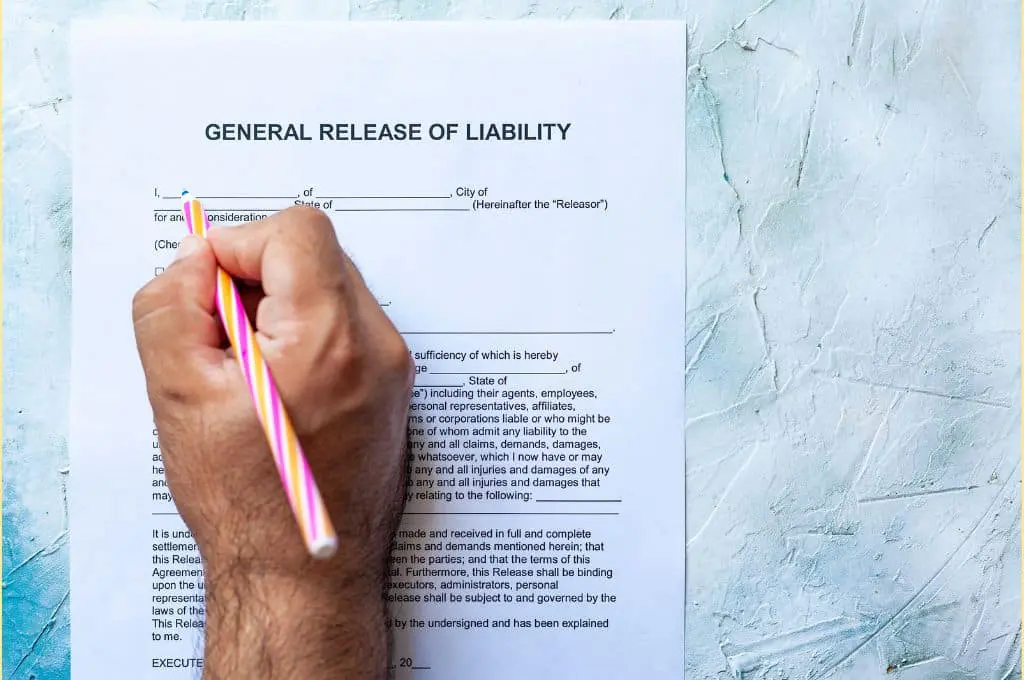Downloading and using content found online is not always legal. Similarly, trying out a new activity may require legal action if something goes wrong. You have the right to sue someone.
You must also obtain a signed liability waiver before using photos or logos created by or for someone else. In this way, you protect yourself against potential disputes and lawsuits.
So, why should you care about issuing a release of liability form when running a business? This guide covers everything you need to know about this concept and its fundamentals as part of your contract management and strategy.
What Is A Release of Liability Waiver?
A liability waiver is a contract between parties that won’t put the other party at fault for damages or injury. It is commonly used in health, financial, or property risk. The waiver can also be referred to as a release of liability or a hold harmless agreement.
The agreement is signed between the following:
- Releasee – the one who prepared the waiver, and
- Releasor – the one who signs and waives future claims against the former
Despite having a waiver, the law may void it in exceptional cases. So, ensure your legal protections by seeking professional guidance.
If the waiver is so essential, why does your business need it? Keep reading to find out why.
Why Your Business Needs Release of Liability Waivers
As a business owner, you must ensure that your customers are always safe within your premises or when using your services. Sometimes though, accidents happen without any warning. Consequently, some fraudsters try to scam business owners by pretending to get injured to get paid for damages.
For example, you are a business that offers high-risk activities, such as bungee jumping, skydiving, or another sport. Before a customer can jump, you’ll have to explain the risks and get him to sign the waiver.
The same is true when you are renting out equipment to customers. When someone rents your car, you will require them to sign legal documents with essential clauses. For instance, you cannot be held liable for any injuries or property damage they incur in the event of a car accident or due to the driver’s negligence.
You wouldn’t want either incident to happen. The best way you can protect yourself and your business is to have a liability release statement signed.
Legal Considerations for a Release Form
Drafting a waiver requires careful consideration of legal requirements and jurisdictional specifics. Keep these key points in mind to ensure it is effective and valid.
- Voluntary and Knowing Assent – Before signing the waiver, ensure your customer fully understands the document’s implications and voluntarily signs it.
- Enforceability – You must draft the waiver to ensure it can be enforced carefully. The clauses must be clear and should specify the risks involved.
- Adequate Consideration – The waiver becomes legally binding when both parties provide consideration. The person signing the document needs to receive something of value for agreeing to release the other party from any liability that may arise. Participating in an activity or getting a service are both considered considerations.
- Scope and Limitations – The agreement must clearly outline the scope of the release from liability. Other details that must be included in the form are the parties involved, the particular activity or situation, and the potential risks.
When preparing a release form on your own, it is best that you seek advice from a qualified legal specialist to ensure that it will be valid. This is because there are some situations wherein the release of liability form is not enforceable.
Key Elements of a Release of Liability Waiver
In most cases, the release of liability is drafted as a standalone document. But it can also be included as part of a larger contract. While it should contain clear and specific risks, the document should also include these elements:
- Names of both parties
- Acknowledgment and assumption of risk
- Indemnification
- No duress
- Acceptance and liability release clause
- Consideration
- Acknowledgment of qualifications
- Release of specific rights
- Effective dates
- Emergency contact information
- Agreement to follow instructions or guidelines
4 Common Examples of Liability Waivers
Now that you know how necessary waivers and releases of liability forms are, let’s talk about the four common examples of such forms:
Model releases
This type of release form is commonly used in photography and videography. If you are a photographer or videographer, you must get your model to sign a release so that the images you capture may be used for commercial purposes.
Location releases
A business owner who offers facility rentals for personal and commercial use must also have a rental agreement with a release of liability clause. As the business owner, the agreement will release you from any risks and personal injuries during your customer’s event.
Activity releases
When you are offering an activity that may cause personal harm or physical injury (such as martial arts, mountain climbing, skydiving, or many others), you need to have a waiver signed before the activity can be taken.
No matter how physically-capable your customer is, a liability waiver will protect your business from any unwanted injuries that result from his negligence.
Equipment rental
If you rent out specialized tools or motor vehicles, a liability release form is also a must. This includes renting out farm equipment, lawn care equipment, construction tools, and any other hardware that may lead to injury if misused.
Best Practices for Implementing Liability Waivers
There are some things you have to follow to enhance the effectiveness of your liability waivers. Here are some of the best practices you should make:
- Draft the waiver in plain language that can easily be understood by the participant.
Make sure to include important provisions, such as the release of liability and assumption of risk, in the waiver. Highlight these by writing them in bold or capitalized text. - It is best to separate the waiver from other forms or agreements so that the participant can acknowledge its existence.
- Don’t rush the participant into signing the waiver. Encourage him to ask questions if there are things he is unsure of.
- Customize your waiver to address specific risks associated with the activity or service you provide.
- Provide separate waivers for adults and minors. The waiver for the adult should clearly state that he is authorized to provide consent for the minor.
- Maintain an organized record of the signed waivers.
- Regularly review and update your waiver to make sure it reflects current laws and regulations.
- Always get explicit consent from the participant.
It’s best to get the help of a qualified attorney to ensure that your liability waiver complies with the applicable legal requirements.
How Fill Can Help Create Legally-Binding Liability Waivers
The above-mentioned points clearly explain why your business needs a liability waiver. If you still haven’t drafted one, Fill can help you with that.
Our platform comes with carefully-drafted templates that are compliant with legal requirements. By using our premade template, you can easily create a release liability waiver to protect you and your business.
Sign up for free today.






